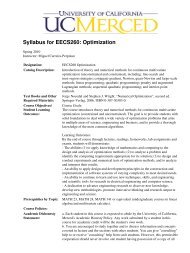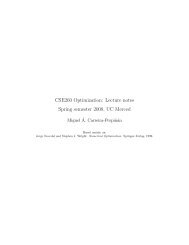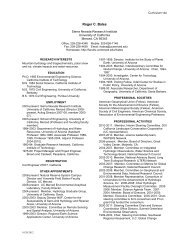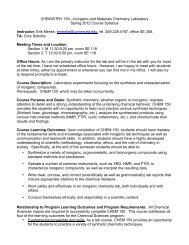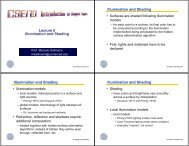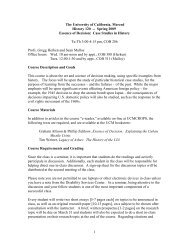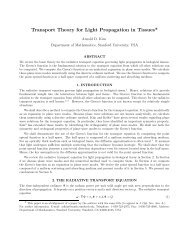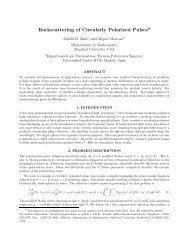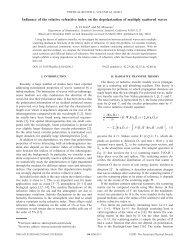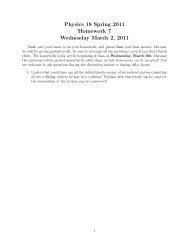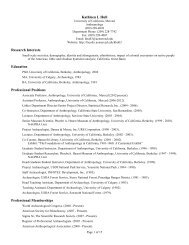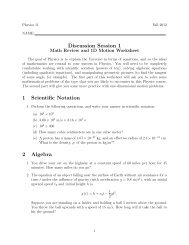Syllabus Instructor: Professor Lin Tian Office: Science and ...
Syllabus Instructor: Professor Lin Tian Office: Science and ...
Syllabus Instructor: Professor Lin Tian Office: Science and ...
Create successful ePaper yourself
Turn your PDF publications into a flip-book with our unique Google optimized e-Paper software.
<strong>Syllabus</strong><br />
<strong>Instructor</strong>: <strong>Professor</strong> <strong>Lin</strong> <strong>Tian</strong><br />
<strong>Office</strong>: <strong>Science</strong> <strong>and</strong> Engineering 226, Phone: 4209, Email: ltian@ucmerced.edu<br />
TA: Yashwant Verma<br />
Email: yverma@ucmerced.edu<br />
Lecture time <strong>and</strong> location: TR 3:00 pm – 4:15 pm, classroom building 286<br />
Discussion/Recitation: R 8:00 am – 8:50 am, classroom building 260<br />
<strong>Office</strong> hour <strong>and</strong> location: T 4:15 pm – 5:30 pm, <strong>Science</strong> <strong>and</strong> Engineering 226<br />
Classmates to contact:<br />
Prerequisities: phys 105 <strong>and</strong> math 23, 24.<br />
Goal: This course is a core physics course for undergraduate physics majors <strong>and</strong> covers<br />
the basic topics in one of the most fundamental subjects in contemporary physics –<br />
quantum mechanics. The goal of this course is to teach basic concepts, theoretical<br />
framework, <strong>and</strong> key experimental phenomena in quantum mechanics, as well as to<br />
develop problem solving skills for undergraduate students. The goal will be achieved<br />
through the combination of lectures, recitation sessions, problem sets, <strong>and</strong> exams.<br />
By the end of this course, the students are expected to be able to:<br />
• solve time-independent Schroedinger equations for eigenvalue problems under<br />
proper boundary condition<br />
• use <strong>and</strong> underst<strong>and</strong> the operator representation of quantum mechanics<br />
• apply several techniques such as perturbation theory, WKB approximation <strong>and</strong><br />
adiabatic approach to study quantum particles under external fields<br />
• underst<strong>and</strong> particle statistics <strong>and</strong> their effects on many body systems.<br />
Text book: Griffiths, David J. Introduction to Quantum Mechanics. 2nd ed. Upper<br />
Saddle River, NJ: Pearson Prentice Hall, 2004. (Book store, amazon.com, half.com)<br />
Other reading materials: Shankar, Ramamurti. Principles of Quantum Mechanics. 2nd<br />
ed. New York, NY: Plenum Press, 1994.<br />
Feynman, R. P. Feynman Lectures On Physics. Vol. 3.<br />
Cohen-Tannoudji, Claude. Quantum Mechanics. 2 vols. New York, NY: Wiley, 1977.<br />
http://www.quantumintro.com/
http://www.chemistry.ohio-state.edu/betha/qm/<br />
Course contents: The course includes 14 weeks of lectures <strong>and</strong> recitation sessions. A list<br />
of topics include:<br />
1. Schroedinger equation <strong>and</strong> probability<br />
2. momentum <strong>and</strong> uncertainty principle<br />
3. time independent equation <strong>and</strong> harmonic oscillator<br />
4. free particle <strong>and</strong> finite square well<br />
5. abstract formalism <strong>and</strong> measurement<br />
6. uncertainty principle <strong>and</strong> Dirac notation – midterm exam<br />
7. spherical coordinate <strong>and</strong> H atoms<br />
8. angular momentum <strong>and</strong> spin<br />
9. Perturbation theory <strong>and</strong> Zeeman effect<br />
10. WKB <strong>and</strong> quantum tunneling<br />
11. Two-level atom <strong>and</strong> spontaneous emission<br />
12. adiabaticity <strong>and</strong> AB effect<br />
13. identical particle <strong>and</strong> periodic table<br />
14. quantum scattering <strong>and</strong> Born approximation<br />
15. exam week, Thursday, Dec.18th 3 pm – 6 pm (check time <strong>and</strong> location)<br />
Homework: will be an integrated part of this course. By working on the problem sets,<br />
the students will be expected to deepen their underst<strong>and</strong>ing of the concepts <strong>and</strong><br />
techniques from class. It will help the student develop problem solving skills as well.<br />
In this class, I will assign homework problems each Thursday at the end of the lecture.<br />
Normally 2 –3 problems will be assigned each week. The due date for the problem set<br />
will be the Thursday of the following week before class starts. Each problem set will be<br />
graded with the full score 100.<br />
Midterm exam <strong>and</strong> final exam: The midterm exam will be held during the 6 th week <strong>and</strong><br />
homework of that week will be reduced. The final exam will be held during the 15 th<br />
week according to university schedule.<br />
Grades determination: The grade will be determined based on performance in problem<br />
sets, midterm exam <strong>and</strong> final exam. The percentage of the grades are: homework %40,<br />
midterm %25, <strong>and</strong> final %35.




